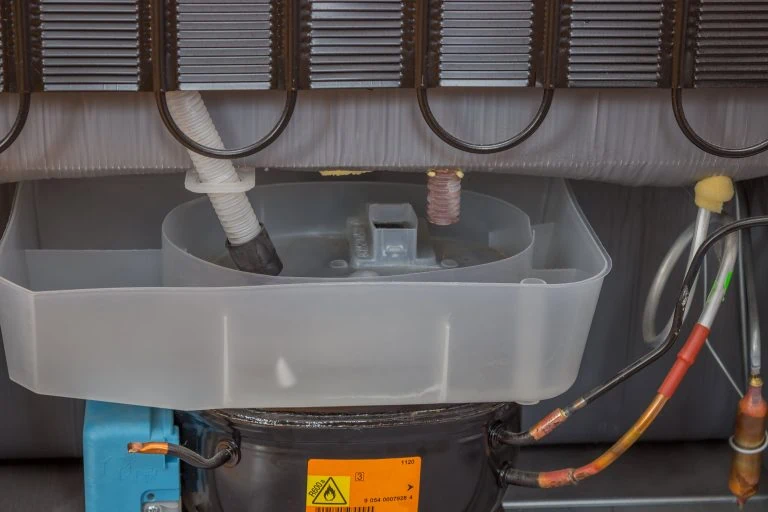
The next stage involves passing the cooled liquid through the capillary tubes running through the body of the refrigerator, which cools everything in the fridge or freezer down. The liquid passes into an evaporator and transforms into pure vapour.
The evaporator is a heat exchange that absorbs heat, allowing the refrigerant to stay cool. The evaporator fan then circulates the cool vapour throughout the refrigerator.
To keep this cycle going, the low pressured vapour needs to turn back into a high pressured liquid, and for this we need- a compressor! As the vapour makes its way through the evaporator, it continues along into the compressor, where it raises the pressure of the refrigerant to its original value.
As both pressure and gas are being compressed, temperature increases and turns the refrigerant into high pressure vapour.
The vapour circulating through the freezer is carrying moisture, and as water cannot be evaporated inside the refrigerator, the cabinet requires regular defrosting. When circulated air comes into contact with the cold evaporator coils, it condenses and begins to frost along the coils. This build up of ice impedes the evaporator’s ability to absorb heat, which derails the cycle, making the refrigerator less efficient.
This is why freezers come with heating rods to help defrost any built up ice. As the ice melts, the water runs down into a pan at the bottom of the refrigerator. The hot condenser coils, assisted by a fan, can then easily evaporate the condensed liquid collected from the defrosted freezer.
Defrost cycles are crucial to commercial refrigeration, and can usually be manually controlled so you can set the stop temperature and frequency of the cycles to make the system as efficient as possible. This allows you to keep the temperature stable inside the refrigerator, which avoids unnecessary peaks in temperature during defrosting.
The compressor is at the heart of the system, breathing life into the whole operation. It knows how hard to run depending on the temperature inside your commercial refrigerator. If the temperature is at the right temperature, the compressor stops, saving you power. If the temperature rises over the temperature limit, the compressor will turn on and start running to get the cooling cycle going again. Digital inverter compressors are the most smooth and efficient compressors when it comes to compression variability. If you’re after a commercial refrigerator with an efficient and reliable compressor, check out Novachill’s range of fridges and freezers, boasting high quality Embraco compressors.
If your commercial refrigerator is on but doesn’t seem to be cooling, then you may have an issue with your temperature controls. The first thing you should check is the placement of your refrigerator. If it’s hard up against the wall, this will affect the unit’s ability to circulate air effectively.
As mentioned before, ice build up is a sign that warm air could be getting into your refrigerator, which can affect the temperature levels. Make sure the doors are all tightly sealed when shut.
If you see some irregularities in your temperature readings, you may have a faulty temperature gauge that needs replacing. Keep a spare thermometer handy so you can place it in the fridge and check yourself. This will show if the thermostat is working and the temperature gauge is giving an accurate reading.
Note that a blocked vent in your refrigerator can also affect the temperature reading.
An inbuilt fan pushes the circulating air around the unit, ensuring an even distribution of cold air. These fans work by cycling air through a distribution plate and back through the evaporator fan to keep the air circling through the internal unit.
Fan forced cooling is superior to static cooling as it circulates cooled air to every corner of the refrigerator, while static cooling results in pockets of warmth and uneven cooling, which puts your fresh stock at risk. Fan forced cooling also has the added benefit of reducing moisture in the air inside the unit, which reduces frost build up.
A reliable and efficient commercial fridge or freezer is a great ally to your business. It’s important to check over your refrigerator and clean it regularly to make sure everything is in working order. A regular inspection by a certified technician is also a great way to keep all those delicate parts working perfectly together in harmony.